|
Spider reproduction, growth and
development
Back to spider home
Sexual dimorphism (differences) is highly
variable among spiders. The primary visible differences between male and female spiders are:
- females have larger/bulkier bodies and/or the entire
female is much larger than the male.
- males generally have enlarged palp ends.
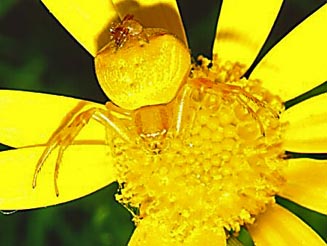 |
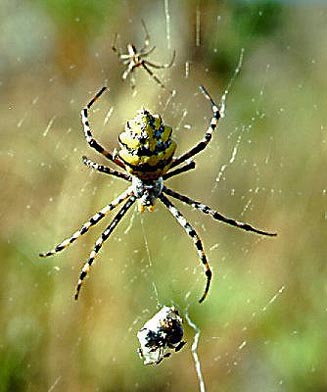 |
| Small male Thomisus sits on
the abdomen of the female waiting to mate. [image N.
Larsen ©] |
Argiope australis (Araneidae) male above,
female in middle and wrapped prey below. [image N.
Larsen ©] |
Females are usually larger than the male as the
physical demands and accompanying energy requirements to produce webs and
broods, are far greater. The male is smaller because once mature, his only function is to mate.
Where males are similar in size to the females,
they are generally more slender, with longer legs (Selenopidae,
Sparassidae, Pachygnatha, Tetragnathidae). In some cases the male can be one thousandth of
the weight of the female (Thomisus, Thomisidae; Nephila,Tetragnathidae;
Argiope, Araneidae). In other cases, the male and female are so different
that they may even appear to be different species where males of certain species
mimic wasps or ants (Salticidae; Gnaphosidae; Seothyra,
Eresidae). back
The copulatory organs of the Araneomorpha (see diagrams under Anatomy), or true spiders,
have entelegyne features. The male
palps are enlarged distally (at the ends) due to a complex copulatory organs
or genital bulbs that resemble boxing gloves. Some tiny male spiders have ridiculously large palps relative to their body size.
The male and female genital organs are very
specific and function on a "lock and key" principle. These organs are used to
identify spiders to species level. The female genitalia, the epigyne, is
situated ventrally (underside) between the booklung slits on the epigastric
furrow. The epigyne is a black, shiny, chitinous, oval to round plate with two
openings.
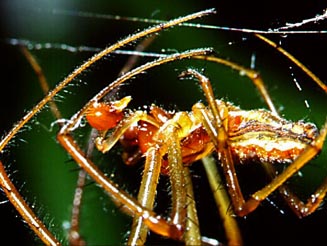
|
|
|
Leucage
(Tetragnathidae) male. Note
enlarged palps. [image N. Larsen ©] |
|
In the primitive spiders, for example
Mygalomorpha and haplogyne Araneomorpha, the genitalia have
haplogyne features where the female has no epigyne
and the males no complex copulatory palps. Instead, the male has a simple bulb that resembles an elongated sting
of a scorpion and this is held
against the ventral surface of the palp and is not easily visible. Due to
the absence of visible genitalia in this group, other characters must be used to determine
species. back
The male copulatory bulb has an internal spiral spermaphor
into which sperm, previously ejaculated from the epigastric furrow, onto a
specially constructed sperm web, is drawn up much like the action of a pipette.
Once the organs on the palps are charged, the male seeks a receptive
mate. Once mature, the male abandons all usual activities such as web
construction and prey capture and transforms into a sexual opportunist. Mating
is triggered in early or late Summer and is initiated either by direct contact,
visual recognition or the stimulus of the female pheremones.
Spider courtship is hazardous, to say the least. For the male spider, mating is not the spontaneous,
playful and flirtatious liason of some animals. It requires planning ahead, a good strategy, knowing the whims of
your future mate and in some cases, the ability to perform long, arduous
routines to please her - sometimes at the risk of being eaten by her. Once he has located a mate, the male spider dare not make a false move as it
would mean certain death so the female is approached cautiously.
The male uses various courtship techniques to
ensure success. Some males become lodgers and may "piggyback" the female and wait for her final maturing moult
ensuring he is in the right place at the right time (Thomisus: Thomisidae).
Some of the orb-web males use gifts and present the female with
a fly wrapped in silk and then mate with her while she is distracted by her
meal. Others web-bound males use musical code. Using their palps, they drum on the outer
spirals of the female's web but only the correct vibration will ignite her
passion. In fact, an artificial signal using a tuning fork can induce a similar
response from a female. In some
species, bondage is preferred and the female is secured by the male with silk before mating
(Xysticus, Thomisidae). Salticidae and
Lycosidae males use certain rituals of waving and
dancing, to interest, placate, mesmerize and excite the female. Of course, there
are always the party poopers who prefer a life without challenges and couldn't be bothered with foreplay and
courtship at all, and just get down to basics straight way.
Copulation involves the injection of sperm from
the male's genital palps, one after the other, via the embolus into the female
epigyne. This can take a few minutes or up to 3 hours as with the Theraphosidae
(baboon spiders). In certain species the palp breaks off and seals the epigyne
while others, after mating, make a dash for safety to seek yet another mate. The
best known scenario is off course where the exhausted male is captured and
devoured by the female after mating and ends up as sustenance for the very brood he
sired, or the female tolerates his company after mating with a very well-hidden
agenda as he is later eaten by the spiderlings instead.
What a shame, we might say but it is of little consequence as the male dies
shortly after mating anyway. back
As the eggs develop in the female, her abdomen enlarges.
After a period varying from 1 week to several months after mating, the female
lays her eggs in the safety of darkness. About 1000 eggs can be laid in 8-10
minutes. Some spiders only produce a few eggs while Argiope (Araneidae),
for example, can produce up to 9000 eggs and only about 2% survive to
maturity.
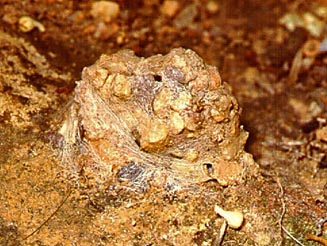
|
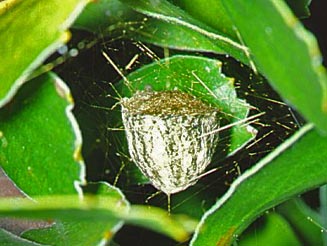
|
| Tama arida
(Hersiliidae)
nest. [image N. Larsen ©] |
Argiope australis
(Araneidae) nest. [image N. Larsen ©] |
The eggs are expelled from the
epigastric furrow in a viscous liquid that dries when it comes into contact with
air, cementing the eggs together. This is done onto a basal disc of silk covered in flocculent
(fluffy) silk that she constructed beforehand and this is in turn attached to
vegetation or included in her web. It is only during the egg-laying process that
the eggs come into contact with the male sperm and are fertilized. The eggs are
then covered with more flocculent silk that traps air that insulates the eggs and
protects them from dehydration and predators such as ants. Usually 1-3 cocoons
are constructed, each one taking about an hour or longer. Eggs that are laid in Summer
hatch within a week or two while those laid at the end of Summer will
over-winter and hatch the following Spring or Summer.
|
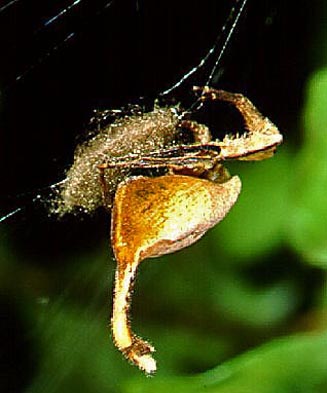
|
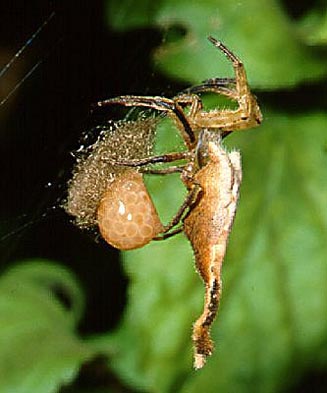
|
|
Arachnura scorpionoides (Araneidae) female
preparing the basal disc. [image N. Larsen ©] |
Arachnura scorpionoides
(Araneidae) female laying her eggs. [image N. Larsen
©] |
|
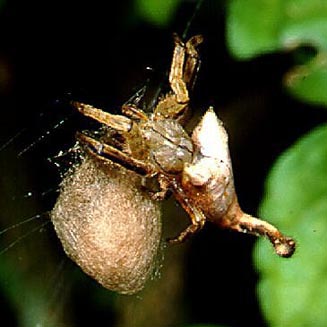
|
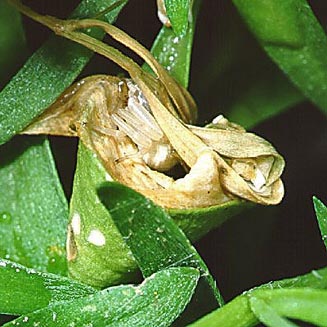
|
|
Arachnura scorpionoides
(Araneidae) female
with completed egg sac. [image N. Larsen ©] |
Thomisus (Thomisidae) in her retreat
with her eggs. [image N. Larsen ©] |
In general, the female either dies after producing her
last brood or lives only long enough to protect her off-spring until they hatch.
However, the theraphosids are exceptions. They only mature after 5 to 7 years
and continue moulting for the remaining 20, or so, years of their lives,
re-mating after each moult.
The cocoons are as diverse as the spiders themselves. They
can be camouflaged with grains of sand, bark or vegetation; or concealed under
leaves, vegetation, stones or bark; concealed in the web amongst prey remains or
carried around by the female (Lycosidae).
back
The spiderlings emerge from the eggs using an egg tooth
and they all hatch simultaneously. They are unable to produce silk or feed and
depend on the egg yolk for inititial sustenance. After 1 to 2 moults, they leave the
cocoon, and cluster together in a mass of fine silk webbing, remain in a nursery
web or stay in webbing used to attach the cocoon to vegetation, guarded by the
mother.
Palystes constructs a cocoon that consists of a silken bag the
size of a fist with leaves woven into it. This provides a safe haven before the
spiderlings disperse, further safety provided by the female who guards her brood
aggressively, either sitting on the nest or close by, out of sight. The lycosids
are unique in that the spiderlings leave the cocoon and travel with the female
on her abdomen. Other spiderlings live with their mothers in a silken retreat or
burrow (Palpimanidae and Theraphosidae).
After a few months, once the spiderlings can produce silk
and can eat, they start to disperse. back
Growth is facilitated by a series of moults called ecdyses.
Except for the soft, pliable abdomen, the spider is covered by a hard chitenous exoskeleton
(outer skeleton) that is likened to a suit of armour. This is fixed and cannot
grow therefore growth takes place in stages with each moult.
Prior to ecdysis, the spider stops feeding and retreats to
a place of safety. In fact, they appear to be dying. The body darkens and the
abdomen swells and separates away from the cepahlothorax, revealing the pedicel
(joint between cephalothorax and abdomen). This process takes a few days as enzymes form a new exoskeleton within
the old. Enzymes both facilitate the loosening of the old skeleton and the
re-absorption of some of the old skeleton into the new thereby conserving
energy. In most cases the spider hangs inverted, suspended from a silk thread
and in the case of the Theraphosidae, they lie on their backs. The heartbeat
increases rapidly, increasing the haemolymph (spider blood) pressure that
triggers the splitting of the pleurae (area from which the appendages emerge and
that hold the carapace and sternum together) along the cephalothorax. Continual, slow
pulsing movements of the spider extend the splitting along the sides of the abdomen
that is no longer soft and pliable and therefore splits easily. (M.
Cochrane observed Ceratogyrus
(Theraphosidae) ecdysing and the horn on the cephalothorax was seen to
rotate slowly). With continual flexing, the spider emerges slowly, first its
body from the top its old "skin", then the legs, clustered together, are slowly eased out
of the sleeves of its old garment.
|
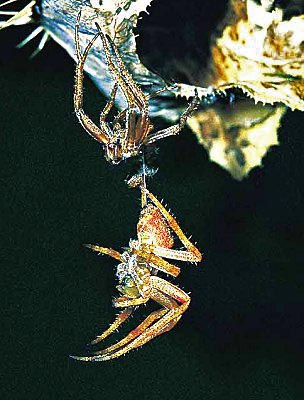
|
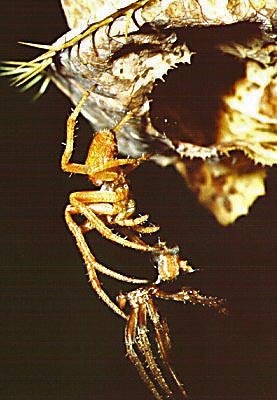
|
|
Neoscona
(Araneidae) ecdysing with exuvium above. [image N.
Larsen ©] |
Neoscona
(Araneidae) disposing of the exuvium after ecdysing. [image
N. Larsen ©] |
The process of ecdysis has its hazards. The spider can
lose a limb, be unable to extricate itself or fall prey to ants and other
predators. If an appendage is lost, it is easily regenerated if lost within the
first few moults.
The number of ecdyses varies with different spiders from3 to 10 times and spiders grow about 20% with each
moult. While the carapace can increase in weight by about 80%, the abdomen is
usually smaller as it loses weight. The abdomen is dependent on food intake.
Smaller spiders
undergo fewer moults than the larger spiders. Males mature one moult before the
females to ensure readiness for mating. The discarded exoskeleton is called an exuvium and retains all the external
features of the spider.
Text by Norman Larsen © |
